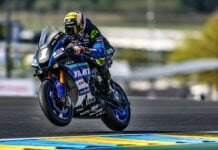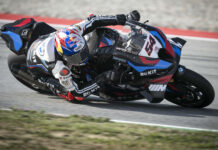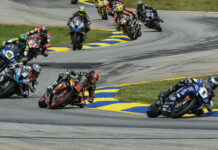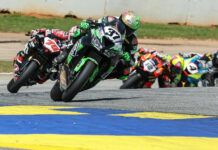From a press release issued by Michelin:
MICHELIN’S FOUR-STROKE FORCE EXPANDS AT STEAMY SEPANG
The new-look MotoGP World Championship gets closer to going all-four-stroke this weekend at Sepang where four-stroke machines will account for half of the MotoGP grid for the first time. Just one week after Alex Barros (West Honda Pons RC211V-Michelin) forsook his NSR500 two-stroke to win at Motegi, Olivier Jacque (Gauloises Yamaha Tech 3 YZR-M1-Michelin) and Shinya Nakano (Gauloises Yamaha Tech 3 YZR-M1-Michelin) have consigned their YZR500 two-strokes to history, bringing the total of four-stroke bikes to twelve. Next year it’s expected that the entire MotoGP grid will be four-stroke, bringing a quarter of a century of two-stroke domination to an end.
Jacque and Nakano couldn’t have chosen a better place to make the switch, for Sepang is expected to favour the new breed of 200-plus horsepower four-strokes more than any of the other 15 Grand Prix circuits. Most pit-lane experts expect newly crowned MotoGP World Champion Valentino Rossi (Repsol Honda Team RC211V-Michelin) and his rivals to smash the existing 500 track record by around two seconds.
Sunday’s Malaysian GP is the 14th of the season and falls immediately after last weekend’s Pacific GP in Japan and before next weekend’s Australian GP. The first-ever four-stroke-based MotoGP season concludes at Valencia, in Spain, on November 3.
MICHELIN TYRES AND SEPANG
Sepang is one of the more challenging events on the Grand Prix calendar – mainly because of the withering tropical weather conditions. The high ambient temperatures, often around 35 degrees, can raise track surface temperature to over 50 degrees, a massive increase over that experienced at most GP circuits. It is Michelin’s job to ensure that their tyres offer riders maximum grip and endurance in these torrid conditions, and the company’s superb record at the Malaysian GP suggests that the French tyres manage this better than any others. Michelin has won all but two of the 11 premier-class GPs staged in Malaysia since 1991, at Shah Alam, Johor and Sepang.
“In normal conditions, most European GP circuits have a track surface temperature of around 35 degrees, so Sepang can be around 40 per cent hotter,” says Michelin Grand Prix manager Emmanuel Fournier. “But tyre temperature doesn’t increase by anything like as much, because we manage it by adjusting compounds and constructions. This is one of the toughest tracks for tyres, so it will be a big challenge for us, just like every race this year, because every circuit is new for the four-strokes. We have made many improvements to our tyres since the start of the season, mainly through construction, but then the bikes have also improved a lot.”
Sepang isn’t only the hottest GP track, it’s also the widest, which adds an extra element to riding technique. “The circuit is almost too wide for bikes!” adds Fournier. “Riders therefore need to be very clever to ride the best-possible lap here, because if they ride white line to white line, as they do at most tracks, for sure they won’t be so fast. The track is so wide that riders can use many, many different lines through each corner, so it’s the kind of place where we can see riders really use their talent to produce the best lap time. Also, they can change their lines from lap to lap, maybe sacrificing corner entry speed at one turn to increase their exit speed, or vice versa. And, of course, this makes it easier for riders to overtake each other.
“I think this will be a tough weekend for the two-stroke riders. We are still developing tyres for the 500s but Sepang is fast and open, so the more powerful four-strokes will have a definite advantage.”
Two years ago at Sepang Michelin tested an air-drying system for their paddock compressors, but while these units are widely used in similar conditions in car racing, they’re not so useful in bikes. “The volume of air within a motorcycle tyre is much smaller than that of an F1 car tyres,” explains Fournier. “So the pressure increase caused by the heat vapourising the wet air is negligible.”
SHINYA NAKANO AND SEPANG
There will be few happier people in the Sepang paddock than Shinya Nakano, who this weekend races a four-stroke MotoGP bike for the first time. Runner-up in the 250 World Championship two years ago, Nakano has raced 500s for the past two seasons, scoring a podium finish during his debut premier-class campaign, but this year hasn’t been so easy for the meek and mild Japanese star. The advent of the new four-stroke-based MotoGP rules has left Nakano struggling to keep up on his traditional 500, but from now on he’s four-stroke-mounted and aiming to get back up front.
Nakano and team-mate Olivier Jacque get one YZR-M1 each for the last three races of the 2002 MotoGP World Championship. The bikes are almost exactly like those raced by Max Biaggi (Marlboro Yamaha Team YZR-M1-Michelin) and Carlos Checa (Marlboro Yamaha Team YZR-M1-Michelin), who have scored one win and four pole positions between them over the last few months.
And Nakano could hardly have chosen a better track at which to make his M1 debut. “Sepang is a good track for four-strokes and it’s also one of my favourite tracks – I won the 250 GP here in 2000 and last year I was only three tenths off a podium finish in the 500 GP,” says the former Japanese 250 champ who celebrated his 25th birthday the day before Malaysian GP qualifying got underway. “I like it because I like fast corners and it’s a fast track, which rewards smooth riding. But Sepang is a hard race –for the tyres, for the engine and also for the rider. The weather is always very hot and humid, and even though Japanese riders are more accustomed to these conditions, Sepang is still tough for us.
“The grip is so-so but the surface temperature is so hot that you can push very hard from the very first lap. The high temperatures also mean that you get even more feel when the tyres slide, though they do slide more than usual. But I don’t have to think about conserving my tyres at this track, it’s never a concern, so long as I work to choose the best tyres with my crew and with Michelin. I go flat-out from the start, no worries, and I push all the way. Maybe you have some big slides over the final few laps but it’s not a problem.
“Last winter Olivier and I did a lot of front-tyre testing for Michelin and I used to have ‘my own’ front, but midseason I changed back to a more standard front slick and I’m quite happy with that. Michelin have been working very hard on both front and rear tyres, and not only for the four-strokes. I’m surprised how much effort they’ve put into their 500 tyres, considering that the 500s won’t be around for much longer, though I’ve appreciated their help. But now, of course, I change to four-strokes!
“I tested the M1 at Yamaha’s Fukuroi test track during the summer break and also again at Shah Alam this week. It’s obviously important to get as much time as possible on the bike because I’ve never raced a four-stroke before, not even at the Suzuka Eight Hours. But I’ve been surprised by the M1, I’ve found it easy to ride and not so much different from the 500. The main thing is that it’s faster, especially on acceleration, and it can do quicker lap times, which is all that really matters to me! This has been a difficult season for 500 riders because it’s been impossible to be competitive with the four-strokes at most tracks, so I’m looking forward to being able to fight up front once again. The M1 does good lap times easily and it seems to look after its tyres well, because the power delivery is smoother, so I think I’m going to be having a lot of fun over the next few races.”
SEPANG DATA
Lap record
Valentino Rossi (Repsol Honda Team NSR500-Michelin), 2:06.618, 157.741kmh/98.016mph (2001)
2001 pole position
Loris Capirossi (West Honda Pons NSR500-Michelin), 2:05.637
Recent winners of the Malaysian GP
2001 Valentino Rossi (Nastro Azzurro Honda NSR500-Michelin), 44:46.652
2000 Kenny Roberts (Telefonica Movistar Suzuki RGV500-Michelin) 31:58.102 (race stopped early due to rain)
1999 Kenny Roberts (Suzuki Grand Prix Team RGV500-Michelin), 44:56.033
1998 Mick Doohan (Repsol Honda NSR500-Michelin), race held at Johor
1997 Mick Doohan (Repsol Honda NSR500-Michelin), race held at Shah Alam
1996 Luca Cadalora (Kanemoto Honda NSR500-Michelin), race held at Shah Alam
Michelin’s partners
Repsol Honda Team-Michelin (4S)
Valentino Rossi
Tohru Ukawa
Marlboro Yamaha Team-Michelin (4S)
Max Biaggi
Carlos Checa
Telefonica Movistar Suzuki Team-Michelin (4S)
Kenny Roberts
Sete Gibernau
West Honda Pons-Michelin (2&4S)
Loris Capirossi (2S)
Alex Barros (4S)
Fortuna Honda Gresini-Michelin (4S)
Daijiro Kato
Gauloises Yamaha Tech 3-Michelin (4S)
Shinya Nakano
Olivier Jacque
Antena 3 Yamaha-d’Antin-Michelin (2S)
Norick Abe
Pere Riba
Michelin Previews Malaysian Grand Prix
Michelin Previews Malaysian Grand Prix
© 2002, Roadracing World Publishing, Inc.






